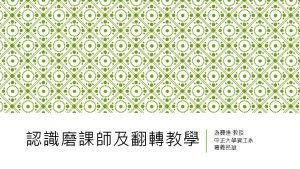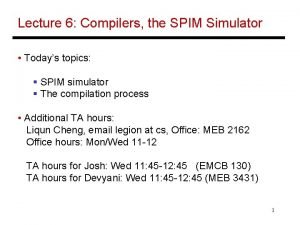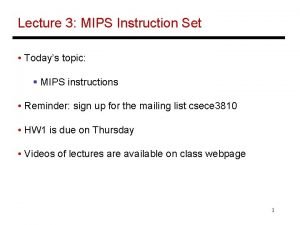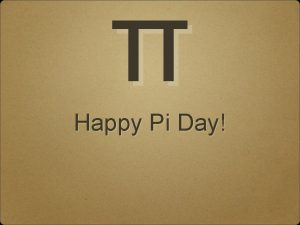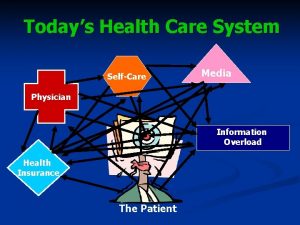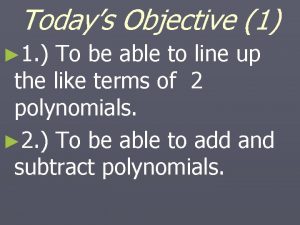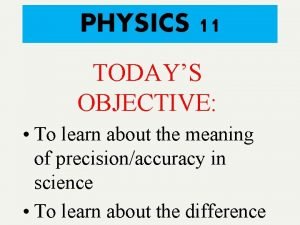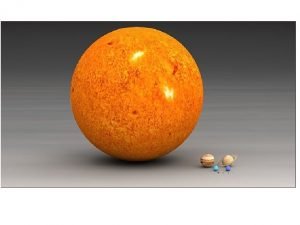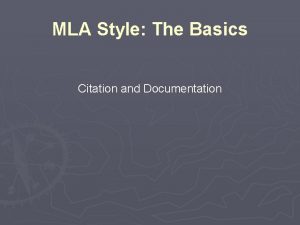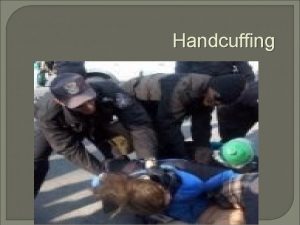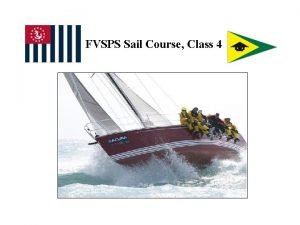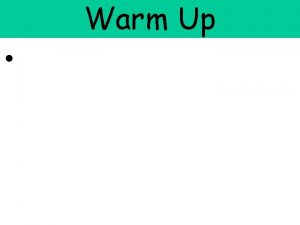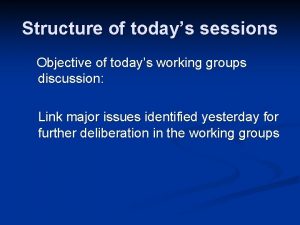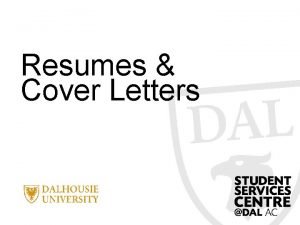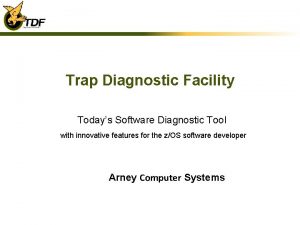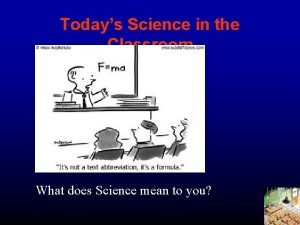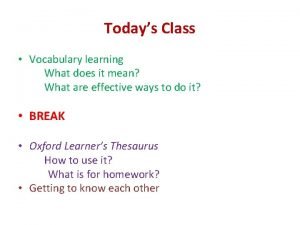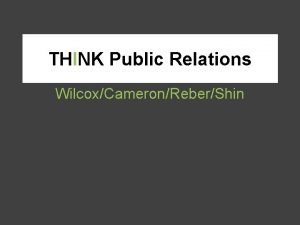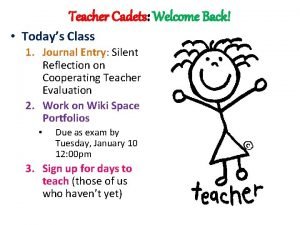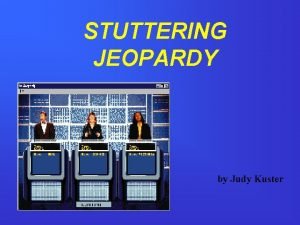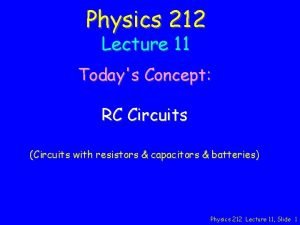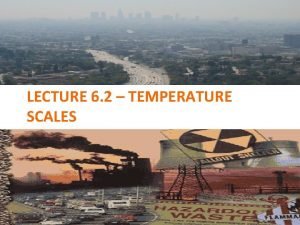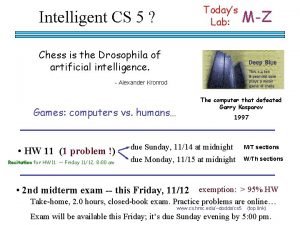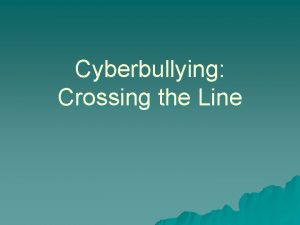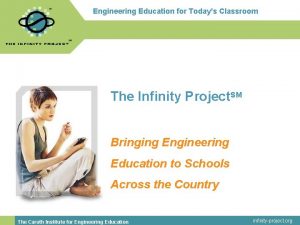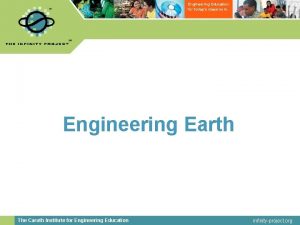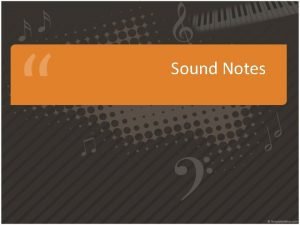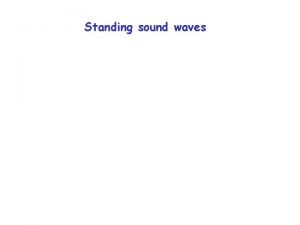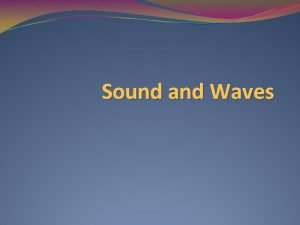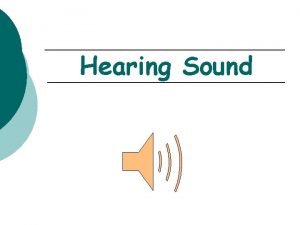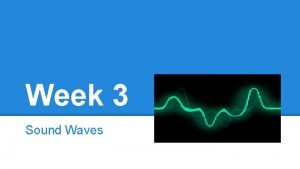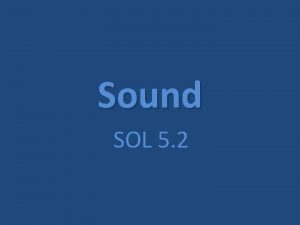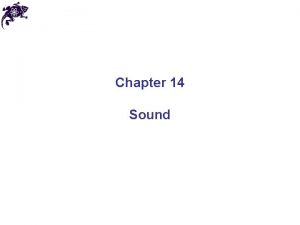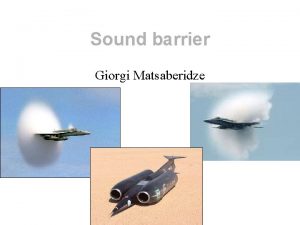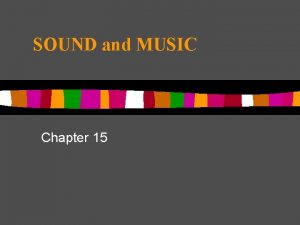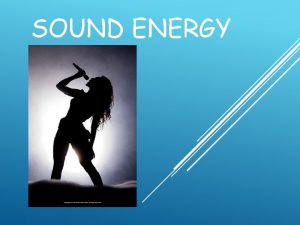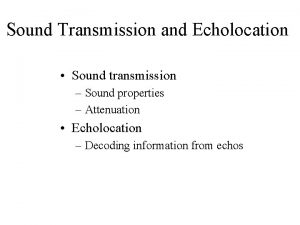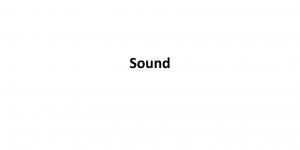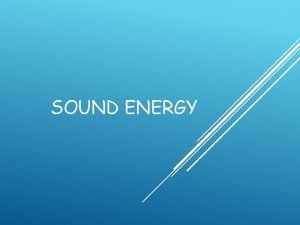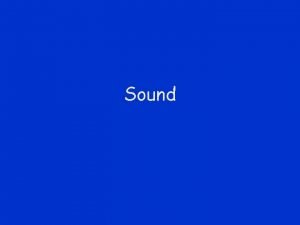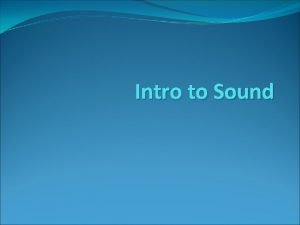Engineering Education for todays classroom Unit 1 Sound






























































- Slides: 62

Engineering Education for today’s classroom. Unit 1: Sound Mixing, Demixing and Spatial Audio © 2005 -2008 The Institute for Engineering Education at SMU. All Rights Reserved infinity-project. org

Engineering Education for today’s classroom. 1. 1 Sound Mixing and Demixing Ø When two or more sound waves are created near each other, such as two musical instruments playing a tune, the sound waves combine together to make one sound wave. Ø Your brain tries to imagine what could have possibly made the sound. Ø It is hard to make an artificial or electronic device, such as microphones connected to a digital computer or processor, do the same thing. © 2005 -2008 The Institute for Engineering Education at SMU. All Rights Reserved infinity-project. org

Engineering Education for today’s classroom. Sound Mixing and Demixing Audio Examples © 2005 -2008 The Institute for Engineering Education at SMU. All Rights Reserved infinity-project. org

Engineering Education for today’s classroom. Building A Sound Separation System Ø These sounds were recorded using actual microphones Ø Can we process the recordings to pull out individual voices? YES! © 2005 -2008 The Institute for Engineering Education at SMU. All Rights Reserved infinity-project. org

Engineering Education for today’s classroom. Mission: Visioneer It Video (Show this to your students!) © 2005 -2008 The Institute for Engineering Education at SMU. All Rights Reserved infinity-project. org

Engineering Education for today’s classroom. 1. 2 The Math Behind Demixing Sounds • Suppose we have a speech sound = Speech • And, noise sound that we call = Noise • A microphone signal picks up 50% of Speech and 50% of Noise” Mic 1 = (0. 5 x Speech) + (0. 5 x Noise) More realistic: Mic 1 = (0. 4 x Speech) + (0. 6 x Noise) Mic 2 = (0. 3 x Speech) + 0. 7 x Noise) Question: Why are the microphone mixtures different? © 2005 -2008 The Institute for Engineering Education at SMU. All Rights Reserved infinity-project. org

Engineering Education for today’s classroom. Two Ears Might be Better than One Ø Idea: Add the microphone signals together Mic 1 + Mic 2 = (0. 4 x Speech) + (0. 6 x Noise) +(0. 3 x Speech) + 0. 7 x Noise) = (0. 4 + 0. 3) x Speech + (0. 6 + 0. 7) x Noise = (0. 7 x Speech) + (1. 3 x Noise) Ø Concept: When the number in front of one sound is bigger, it is louder than the other sound Ø In practice, only relative levels matter, so we can turn the amounts into percentages again 0. 5 x (Mic 1+Mic 2) = (0. 35 x Speech) + (0. 65 x Noise) © 2005 -2008 The Institute for Engineering Education at SMU. All Rights Reserved infinity-project. org

Engineering Education for today’s classroom. Two Ears Might be Better than One Ø How Do We Cancel the Noise? Idea: Subtract microphone signals Mic 1 - Mic 2 = (0. 4 x Speech) + (0. 6 x Noise) - [(0. 3 x Speech) + 0. 7 x Noise)] = (0. 4 - 0. 3) x Speech + (0. 6 - 0. 7) x Noise = (0. 1 x Speech) - (0. 1 x Noise) Ø Ears ignore negative signs: - (0. 1 x Noise) sounds like (0. 1 x Noise) Ø Turn fractions into percentages again: 0. 1 + 0. 1 = 0. 2, so 5 (Mic 1 – Mic 2) = (0. 5 x Speech) – (0. 5 x Noise) Ø How can we do better than this? © 2005 -2008 The Institute for Engineering Education at SMU. All Rights Reserved infinity-project. org

Engineering Education for today’s classroom. Size of Signals and Volume Ø Multiplying Signals by a Constant If Mic 1 = (0. 4 x Speech) + (0. 6 x Noise), then 2 x Mic 1 = (0. 8 x Speech) + (1. 2 x Noise) would be “twice as loud” as Mic 1. © 2005 -2008 The Institute for Engineering Education at SMU. All Rights Reserved infinity-project. org

Engineering Education for today’s classroom. Separating the Speech Signal from Noise Ø Combine the ideas of adding and subtracting signals with changing the volumes of signals. Suppose we take 0. 9 times Mic 2 and subtracted it from Mic 1. We would get Mic 1 - (0. 9 x Mic 2) = (0. 4 x Speech) + (0. 6 x Noise) - 0. 9 x [(0. 3 x Speech) + (0. 7 x Noise)] = (0. 13 x Speech) - (0. 03 x Noise) The speech is now more than 4 times louder than the noise (0. 13/0. 03) = 4. 333… © 2005 -2008 The Institute for Engineering Education at SMU. All Rights Reserved infinity-project. org

Engineering Education for today’s classroom. Separating the Speech Signal from Noise Ø Refining the result (advanced): Suppose we take 0. 86 times Mic 2 and subtracted it from Mic 1. We would get Mic 1 - (0. 86 x Mic 2) = (0. 4 x Speech) + (0. 6 x Noise) - 0. 86 x [(0. 3 x Speech) + (0. 7 x Noise)] = (0. 4 x Speech) - (0. 258 x Speech) + (0. 6 x Noise) - (0. 602 x Noise) = (0. 142 x Speech) - (0. 002 x Noise) The speech is now 71 times louder than the noise. (0. 142/0. 002 = 71) © 2005 -2008 The Institute for Engineering Education at SMU. All Rights Reserved infinity-project. org

Engineering Education for today’s classroom. Separating Speech and Noise in the Lab Ø Designing the system - two ways 1. Using calculations as we have up to now 2. Turn the number in front of Mic 2 into a control and playing with the control until the noise goes away. Let’s try the second method using the Lab. VIEW labs: 01 Listen. To. Original. Speechand. Noise 02 Listen. To. Mixed. Speechand. Noise 03 Separate. Speechand. Noise. Slider © 2005 -2008 The Institute for Engineering Education at SMU. All Rights Reserved infinity-project. org

Engineering Education for today’s classroom. 01 Listen. To. Original. Speechand. Noise © 2005 -2008 The Institute for Engineering Education at SMU. All Rights Reserved infinity-project. org

Engineering Education for today’s classroom. 02 Listen. To. Mixed. Speechand. Noise © 2005 -2008 The Institute for Engineering Education at SMU. All Rights Reserved infinity-project. org

Engineering Education for today’s classroom. 03 Separate. Speechand. Noise. Slider © 2005 -2008 The Institute for Engineering Education at SMU. All Rights Reserved infinity-project. org

Engineering Education for today’s classroom. Worksheet Exercise 1. 1 For the following exercises, let Mic 1 = (0. 2 x Speech) + (0. 8 x Noise) Mic 2 = (0. 3 x Speech) + (0. 7 x Noise) Calculate the following signals. 1. Mic 1 + Mic 2 = (_____ x Speech) ____ (_____ x Noise) 2. Mic 1 - Mic 2 = (_____ x Speech) ____ (_____ x Noise) 3. (2 x Mic 1) = (_____ x Speech) ____ (_____ x Noise) 4. (0. 7 x Mic 1) = (_____ x Speech) ____ (_____ x Noise) 5. (1. 5 x Mic 2) = (_____ x Speech) ____ (_____ x Noise) Question: In which of the above cases is (a) Speech louder than Noise? (b) Speech softer than Noise? (c) Speech and Noise of the same volume? . © 2005 -2008 The Institute for Engineering Education at SMU. All Rights Reserved infinity-project. org

Engineering Education for today’s classroom. Worksheet Exercise 1. 2 For the following microphone signal pairs, find the volume needed for the Mic 2 signal that, when subtracted from the Mic 1 signal, removes the noise signal completely. 1. Mic 1 = (0. 3 x Speech) + (0. 7 x Noise) Mic 2 = (0. 5 x Speech) + (0. 5 x Noise) 2. Mic 1 = (0. 6 x Speech) + (0. 4 x Noise) Mic 2 = (0. 2 x Speech) + (0. 8 x Noise) 3. Mic 1 = (0. 1 x Speech) + (0. 4 x Noise) Mic 2 = (0. 5 x Speech) + (0. 6 x Noise) 4. Mic 1 = (1. 2 x Speech) + (0. 9 x Noise) Mic 2 = (0. 8 x Speech) + (0. 4 x Noise) © 2005 -2008 The Institute for Engineering Education at SMU. All Rights Reserved infinity-project. org

Engineering Education for today’s classroom. Separating Speech and Noise Using Math Ø Recall: Designing the system - two ways 1. Using calculations 2. Playing with the control on Mic 2 until the noise is gone. Let’s try the first method using the numbers we’ve just calculated using the lab: 03 Separate. Speechand. Noise. Slider © 2005 -2008 The Institute for Engineering Education at SMU. All Rights Reserved infinity-project. org

Engineering Education for today’s classroom. 03 Separate. Speechand. Noise. Slider © 2005 -2008 The Institute for Engineering Education at SMU. All Rights Reserved infinity-project. org

Engineering Education for today’s classroom. 1. 3 Designing a Two-Talker Speech Separation System • Suppose we have two speech sounds Speech 1 and Speech 2, and we record two different mixtures. • How does the problem change? – Most important: Which speech signal is the one we want to hear? – Maybe we need a system that has two outputs: • Separated Speech 1 • Separated Speech 2 – So, we need a system that calculates two different combinations of Mic 1 and Mic 2 – We will choose later which sound to which we will listen. – For now, we’ll use a single combination and change the slider to hear the talker we want. © 2005 -2008 The Institute for Engineering Education at SMU. All Rights Reserved infinity-project. org

Engineering Education for today’s classroom. Differences Between Noise and Speech • A lot of noises are always “on”, making sound every second • But speech is impulsive or intermittent. Sometimes there’s no talker speaking. How does this fact change the design process? – It doesn’t change anything about the math, but it does make the “playing with the slider” design method harder. Try it with the labs: 04 Listen. To. Original. Speech 2 05 Listen. To. Mixed. Speech 2 06 Separate. Speech 2 Slider © 2005 -2008 The Institute for Engineering Education at SMU. All Rights Reserved infinity-project. org

Engineering Education for today’s classroom. 04 Listen. To. Original. Speech 2 © 2005 -2008 The Institute for Engineering Education at SMU. All Rights Reserved infinity-project. org

Engineering Education for today’s classroom. 05 Listen. To. Mixed. Speech 2 © 2005 -2008 The Institute for Engineering Education at SMU. All Rights Reserved infinity-project. org

Engineering Education for today’s classroom. 06 Separate. Speech 2 Slider © 2005 -2008 The Institute for Engineering Education at SMU. All Rights Reserved infinity-project. org

Engineering Education for today’s classroom. The Math Behind Two-Talker Speech Separation • Suppose Mic 1 = (0. 4 x Speech 1) + (0. 6 x Speech 2) Mic 2 = (0. 5 x Speech 1) + (0. 5 x Speech 2) • Separating out Speech 1 Mic 1 - (1. 2 x Mic 2) = (0. 4 x Speech 1) + (0. 6 x Speech 2) - 1. 2 x [(0. 5 x Speech 1) + (0. 5 x Speech 2)] = (0. 4 - (1. 2 x 0. 5)) x Speech 1 + (0. 6 - (1. 2 x 0. 5)) x Speech 2 = - (0. 2 x Speech 1) + (0. 0 x Speech 2) = - (0. 2 x Speech 1) © 2005 -2008 The Institute for Engineering Education at SMU. All Rights Reserved infinity-project. org

Engineering Education for today’s classroom. The Math Behind Two-Talker Speech Separation • Separating out Speech 2 Mic 1 - (0. 8 x Mic 2) = (0. 4 x Speech 1) + (0. 6 x Speech 2) - 0. 8 x [(0. 5 x Speech 1) + (0. 5 x Speech 2)] = (0. 4 - (0. 8 x 0. 5)) x Speech 1 + (0. 6 - (0. 8 x 0. 5)) x Speech 2 = (0. 0 x Speech 1) + (0. 2 x Speech 2) = (0. 2 x Speech 2) • Important Idea: The two separation systems are identical except for the value multiplying Mic 2. • Aside: Engineers re-use system designs all the time so long as they own them (i. e. patents) © 2005 -2008 The Institute for Engineering Education at SMU. All Rights Reserved infinity-project. org

Engineering Education for today’s classroom. Worksheet Exercise 1. 4 For the following microphone signal pairs, a) Find the volume needed for the Mic 2 signal that, when subtracted from the Mic 1 signal, removes Speech 2 completely. b) Find the volume needed for the Mic 2 signal that, when subtracted from the Mic 1 signal, removes Speech 2 completely. 1. Mic 1 = (0. 6 x Speech) + (0. 4 x Noise) Mic 2 = (0. 2 x Speech) + (0. 8 x Noise) 2. Mic 1 = (1. 2 x Speech) + (0. 9 x Noise) Mic 2 = (0. 8 x Speech) + (0. 4 x Noise) © 2005 -2008 The Institute for Engineering Education at SMU. All Rights Reserved infinity-project. org

Engineering Education for today’s classroom. Designing a Two-Talker Speech Separation System in the Lab • Now, we will use our math skills to build a two-talker speech separation system without sliders. • Our goal: For the two mixtures, – Calculate the right amount of Mic 2 in two ways so that we get Speech 1 alone and Speech 2 alone. – We’ll use a button control to toggle between the two outputs. 07 Separate. Speech 2 System © 2005 -2008 The Institute for Engineering Education at SMU. All Rights Reserved infinity-project. org

Engineering Education for today’s classroom. 07 Separate. Speech 2 System © 2005 -2008 The Institute for Engineering Education at SMU. All Rights Reserved infinity-project. org

Engineering Education for today’s classroom. Important Exercises for Lab 8 • Make sure you have the students type in different amounts of Speech 1 and Speech 2 into the mixtures (to simulate different room conditions) • Have them calculate what the right amounts of Mic 2 should be to get Speech 1 and Speech 2 at the output of the system • Discuss with them some of the problems – Sometimes, the volume of the output is too low to hear - need to “turn up the volume” after separation – Is there ever a situation where separation isn’t possible? Yes, if Mic 1 and Mic 2 have identical percentages of Speech 1 and Speech 2 in them. Then, they are the same microphone! © 2005 -2008 The Institute for Engineering Education at SMU. All Rights Reserved infinity-project. org

Engineering Education for today’s classroom. Epilogue: Spatial Audio • When watching movies with surround sound, the sound “moves” with the visual action all around the room. • A sound designer is someone who creates the multichannel audio signals to make this sound movement happen. • How does the sound designer design these sounds? Using math, of course! – Two math tools: Volume (what we have been using) and Delay (time shift - see Unit 2). © 2005 -2008 The Institute for Engineering Education at SMU. All Rights Reserved infinity-project. org

Engineering Education for today’s classroom. Spatial Audio (1. 0 x Speech 1) + (0. 0 x Speech 2) (0. 0 x Speech 1) + (1. 0 x Speech 2) Quick. Time™ and a TIFF (LZW) decompressor are needed to see this picture. (0. 5 x Speech 1) + (0. 2 x Speech 2) (0. 5 x Speech 1) + (0. 8 x Speech 2) © 2005 -2008 The Institute for Engineering Education at SMU. All Rights Reserved infinity-project. org

Engineering Education for today’s classroom. Unit 2: Echo, Reverberation and Sound Effects © 2005 -2008 The Institute for Engineering Education at SMU. All Rights Reserved infinity-project. org

Engineering Education for today’s classroom. 2. 1 The Speed of Sound Ø Sound does not travel (nearly) instantaneously like light does. It takes time for sound to go from one place to another. Ø If air were visible, here’s what a sound wave might look like “frozen” in time: Light areas: Not many air particles Dark areas: Lots of air particles Movement: Moves to right over time - like ripples in a pond © 2005 -2008 The Institute for Engineering Education at SMU. All Rights Reserved infinity-project. org

Engineering Education for today’s classroom. Movement of Sound Waves Ø Sound waves are caused by changes in air density the number of air particles in a particular space Ø These are very small changes - ears hears sound well! Sound movement is similar to wave movement in a spring. (Look at each row of the figure as a frame of a movie going upwards. ) © 2005 -2008 The Institute for Engineering Education at SMU. All Rights Reserved infinity-project. org

Engineering Education for today’s classroom. Traveling Wave in a Spring Push Here-> © 2005 -2008 The Institute for Engineering Education at SMU. All Rights Reserved infinity-project. org

Engineering Education for today’s classroom. Speed of Sound in Different Materials Medium Meters/sec Feet/sec Miles/hour • Air 331 1086 740 • Hydrogen 1270 4167 2841 • Carbon Dioxide 258 846 577 • Water 1450 4757 3244 • Glass 5500 18000 12300 • Granite 6000 19700 13500 UNITS: Distance/Time (“distance over time”) © 2005 -2008 The Institute for Engineering Education at SMU. All Rights Reserved infinity-project. org

Engineering Education for today’s classroom. How to Measure the Speed of Sound in Air Ø Place yourself far away from a large, flat object, like the side of a building. Ø Clap your hands, and start a stopwatch. Ø Wait until you hear the sound come back - the echo. Ø Since the distance traveled is twice the distance from you to the wall, calculate Speed of Sound = (2 x Distance to Wall)/(Time Traveled) Ø Problems: (1) It is hard to start and stop the stopwatch accurately. (2) There may be other reflections from other buildings. Can’t we do this better with a microphone? © 2005 -2008 The Institute for Engineering Education at SMU. All Rights Reserved infinity-project. org

Engineering Education for today’s classroom. Worksheet Exercise 2. 1 A. For each of the distances, calculate how long it would take for a sound of a handclap to travel from your hands to a wall that is the distance away and back again. 1. 5 meters 2. 300 feet 3. 0. 25 miles B. Suppose you are 100 feet away from a large building. It takes 185 milliseconds for an echo of a handclap sound to return to you. What is your measurement of the speed of sound? C. How far away from a wall would you have to be to create an echo in air with the following time delays? 1. 0. 1 seconds 2. 1. 1 seconds 3. 5 seconds © 2005 -2008 The Institute for Engineering Education at SMU. All Rights Reserved infinity-project. org

Engineering Education for today’s classroom. 2. 2 Delay and Amplitude of an Echo Ø When sound bounces of a surface and comes back to us in a distinct reflection that we can hear, we call the sound an echo. Ø Two numbers describe this echo: 1. Echo Delay - the amount of time it takes for the echo to get to us. 2. Echo Amplitude - the size of the echo signal relative to the original sound that produced it. Ø We can measure the delay and the amplitude of an echo in Lab. VIEW. © 2005 -2008 The Institute for Engineering Education at SMU. All Rights Reserved infinity-project. org

Engineering Education for today’s classroom. Plot of Original Sound © 2005 -2008 The Institute for Engineering Education at SMU. All Rights Reserved infinity-project. org

Engineering Education for today’s classroom. Plot of Original Sound With Echo © 2005 -2008 The Institute for Engineering Education at SMU. All Rights Reserved infinity-project. org

Engineering Education for today’s classroom. Calculating the Echo Delay 1. Find some easily recognized point of the first part of the sound, like its largest value or when the sound first starts. 2. Determine the time that this point occurs. For example, the start of the first part of the sound happens at time T_start = 0. 52 seconds. 3. Find the time where this feature repeats. For example, when the sound repeats, the start of the repeated sound happens at time T_repeat = 0. 87 seconds. 4. Subtract the second value from the first one. In this case, 0. 87 – 0. 52 = 0. 35 seconds. This is the echo delay. © 2005 -2008 The Institute for Engineering Education at SMU. All Rights Reserved infinity-project. org

Engineering Education for today’s classroom. Calculating the Echo Delay Using A Transparency 1. Put the transparency over the graph. Draw a straight line for the zero value of the graph. 2. For the first part of the sound, trace out its shape on the transparency. 3. Mark the axis to the left of some feature of this sound using regular units (such as every 0. 1 seconds). 4. Now, slide the transparency over so that the trace that you just drew falls on top of the second part of the sound--the part that repeats. 5. Look at the first part of the sound. Your markings should now tell you exactly what the time delay is--in this case, 0. 35 seconds. © 2005 -2008 The Institute for Engineering Education at SMU. All Rights Reserved infinity-project. org

Engineering Education for today’s classroom. Echo Amplitude Ø When sound bounces off of something, not all of it is reflected back. Some of the sound is lost (absorbed). Ø The echo signal is softer and therefore smaller in amplitude (or height on a graph) than the original sound. Ø We can calculate the amount of the echo amplitude as Echo Amplitude = (Volume of Reflected Signal) / (Volume of Original Signal) Ø Question 1: What is the Echo Amplitude of the echo in the previous plot? Ø Question 2: How did you calculate it? © 2005 -2008 The Institute for Engineering Education at SMU. All Rights Reserved infinity-project. org

Engineering Education for today’s classroom. Measuring Echo Delay and Echo Amplitude in the Lab Ø Let’s use Lab. VIEW to simulate echoes and measure their amplitudes and delays 09 Simple. PCEcho. Delay • Use the Esc key to stop the worksheet. • It takes some timing, but it should be possible to stop the worksheet when both the original sound and the echo are on the same graph. • Calculate the delay and amplitude using the methods we’ve described. © 2005 -2008 The Institute for Engineering Education at SMU. All Rights Reserved infinity-project. org

Engineering Education for today’s classroom. 08 Simple. PCEcho. Delay © 2005 -2008 The Institute for Engineering Education at SMU. All Rights Reserved infinity-project. org

Engineering Education for today’s classroom. Worksheet Exercise 2. 2 A. B. The following T_start and T_repeat times are measured for a sound with echo. Find the echo delay time. 1) T_start = 0. 22 seconds. T_repeat = 0. 32 seconds. T_delay = ______ 2) T_start = 0. 37 seconds. T_repeat = 0. 4 seconds. T_delay = ______ The following volumes are measured for a sound with echo. Find the amplitude of the echo. 1) Volume of Original Signal = 0. 7, Volume of Reflected Signal = 0. 4 Echo Amplitude = ______ 2) Volume of Original Signal = 1. 5, Volume of Reflected Signal = 1. 32 Echo Amplitude = ______ © 2005 -2008 The Institute for Engineering Education at SMU. All Rights Reserved infinity-project. org

Engineering Education for today’s classroom. Worksheet Exercise 2. 2 (cont. ) C. For the following signal, measure and calculate the echo delay and the echo amplitude. T_start = _____ T_repeat = _____ T_delay =_____ Volume of Original Signal = _____ Volume of Reflected Signal =_____ Echo Amplitude =_____ © 2005 -2008 The Institute for Engineering Education at SMU. All Rights Reserved infinity-project. org

Engineering Education for today’s classroom. 2. 3 Recreating Echo Ø Most sounds that are made for music and movies have echo that is artificially-made. Ø The math tools for this are identical to those we have used in the labs to simulate echo. Ø We can use our knowledge of physical space to calculate what the delay ought to be for a particular space. • Example: Sports Stadium: 300 m from one side to another o What should be the echo delay in seconds? o How do you calculate it? 09 Simple. PCEcho. Speech 10 Simple. PCEcho. Stadium © 2005 -2008 The Institute for Engineering Education at SMU. All Rights Reserved infinity-project. org

Engineering Education for today’s classroom. 09 Simple. PCEcho. Speech © 2005 -2008 The Institute for Engineering Education at SMU. All Rights Reserved infinity-project. org

Engineering Education for today’s classroom. 10 Simple. PCEcho. Stadium © 2005 -2008 The Institute for Engineering Education at SMU. All Rights Reserved infinity-project. org

Engineering Education for today’s classroom. 2. 4 Reverberation - Repeating Echo Ø When sound bounces off of two opposing walls, a repeating echo is created. The sound slowly decays away as the amplitude decreases after each bounce. Ø When the distances are short, we don’t hear the distinct echoes, but we still do hear a change - the sound is somehow better to us. Ø This effect is called reverberation. Ø We can use Lab. VIEW to simulate reverberation effects. This takes more number-crunching, so we will use the DSP board. 11 DSPReverberation © 2005 -2008 The Institute for Engineering Education at SMU. All Rights Reserved infinity-project. org

Engineering Education for today’s classroom. 11 DSPReverberation © 2005 -2008 The Institute for Engineering Education at SMU. All Rights Reserved infinity-project. org

Engineering Education for today’s classroom. Hints on Audio Laboratories Ø You might want to demonstrate the lab to the students before having them use it themselves. Ø Headphones are really helpful here. Ø Ask questions of the students to test their understanding of what is going on. Their tendency will be to “just play with the controls, ” so get them back to calculating numbers to verify what they see and hear. © 2005 -2008 The Institute for Engineering Education at SMU. All Rights Reserved infinity-project. org

Engineering Education for today’s classroom. System Design: The Gosney Speaker © 2005 -2008 The Institute for Engineering Education at SMU. All Rights Reserved infinity-project. org

Engineering Education for today’s classroom. Speakers and Microphones • Transducer : something that converts energy from one form to another – Speaker : electricity sound (acoustic) – Microphone : sound electricity • Most inexpensive transducers use electricity and/or magnetism to work. © 2005 -2008 The Institute for Engineering Education at SMU. All Rights Reserved infinity-project. org

Engineering Education for today’s classroom. Loudspeaker Parts • Cut-away view of a typical loudspeaker © 2005 -2008 The Institute for Engineering Education at SMU. All Rights Reserved infinity-project. org

Engineering Education for today’s classroom. The Physics of Loudspeakers Magnetic Flux B Current I B I • Force = (Magnetic Flux) x (Current) – causes the wire to move with small changes in electricity • To get a higher force, we turn the wire into a coil • Then, we attach a rigid cone to the coil © 2005 -2008 The Institute for Engineering Education at SMU. All Rights Reserved S N S infinity-project. org

Engineering Education for today’s classroom. The Gosney Speaker • Let’s Build This! Tab that attaches cone to bowl Wires Paper Cone Button Magnet Coil Plastic Salad Bowl © 2005 -2008 The Institute for Engineering Education at SMU. All Rights Reserved infinity-project. org

Engineering Education for today’s classroom. Wrap-Up Discussion Ø We have covered the basics of the sound engineering curriculum Ø The key idea: Let the application motivate the math and science • Your students will want to make things happen • The key is to show them that they can achieve what they want with technology if they understand it well • Push the responsibility of the design to them as much as possible so that they own the design © 2005 -2008 The Institute for Engineering Education at SMU. All Rights Reserved infinity-project. org

Engineering Education for today’s classroom. Thank You! • Universities and Organizations Involved in the Infinity Project – Created by Institute for Engineering Education at SMU • – Other participating universities include Georgia Institute of Technology, Rose-Hulman Institute of Technology, Rice University, Texas A&M University, University of Texas at Austin, University of Texas at El Paso, Prairie View A&M, University of Michigan, Santa Clara, University of Houston, and many others. Corporate – Government Sponsors and Entities – Texas Instruments – Department of Education – Communities Foundation of Texas – National Instruments – National Science Foundation – Tyco, Compaq, Microsoft – And others © 2005 -2008 The Institute for Engineering Education at SMU. All Rights Reserved infinity-project. org
 Cse smart class
Cse smart class “a sound mind is in a sound body”
“a sound mind is in a sound body” Sound is
Sound is Unit 6 review questions
Unit 6 review questions Education outside the classroom
Education outside the classroom Todays generations
Todays generations Today class or today's class
Today class or today's class Multiple choice comma quiz
Multiple choice comma quiz Todays worldld
Todays worldld Whats todays temperature
Whats todays temperature Todays globl
Todays globl Whats todays wordlw
Whats todays wordlw Chapter 13 marketing in today's world
Chapter 13 marketing in today's world Todays plan
Todays plan Todays sabbath lesson
Todays sabbath lesson Todays sabbath lesson
Todays sabbath lesson Midlands 2 west north
Midlands 2 west north Todays health
Todays health Today's objective
Today's objective No thats not it
No thats not it Today's objective
Today's objective Todays whether
Todays whether Todays vision
Todays vision Todays objective
Todays objective Planetarypositionstoday
Planetarypositionstoday Mla first page
Mla first page Todays final jeopardy
Todays final jeopardy Handcuffing positions
Handcuffing positions Todays weather hull
Todays weather hull Todays objective
Todays objective Date frui
Date frui Todays objective
Todays objective Animal digestive system parts and functions
Animal digestive system parts and functions Todays objective
Todays objective Safe online talk
Safe online talk Define todays
Define todays Todays agenda
Todays agenda Todays jeopardy
Todays jeopardy Teacher : good morning class
Teacher : good morning class Todays jeopardy
Todays jeopardy Todays software
Todays software Todays science
Todays science Todays objective
Todays objective For todays meeting
For todays meeting Today's goal
Today's goal Todays class
Todays class Clients often criticize public relations firms for:
Clients often criticize public relations firms for: Todays price of asda shares
Todays price of asda shares Welcome to today's class
Welcome to today's class Todays final jeopardy answer
Todays final jeopardy answer Todays final jeopardy
Todays final jeopardy Todays concept
Todays concept Whats todays temperature
Whats todays temperature Todays jeopardy
Todays jeopardy Todays lab
Todays lab Organelle jeopardy
Organelle jeopardy Objective of cyberbullying
Objective of cyberbullying Final jeopardy 2/2
Final jeopardy 2/2 Kontinuitetshantering i praktiken
Kontinuitetshantering i praktiken Typiska novell drag
Typiska novell drag Tack för att ni lyssnade bild
Tack för att ni lyssnade bild Ekologiskt fotavtryck
Ekologiskt fotavtryck Varför kallas perioden 1918-1939 för mellankrigstiden
Varför kallas perioden 1918-1939 för mellankrigstiden




